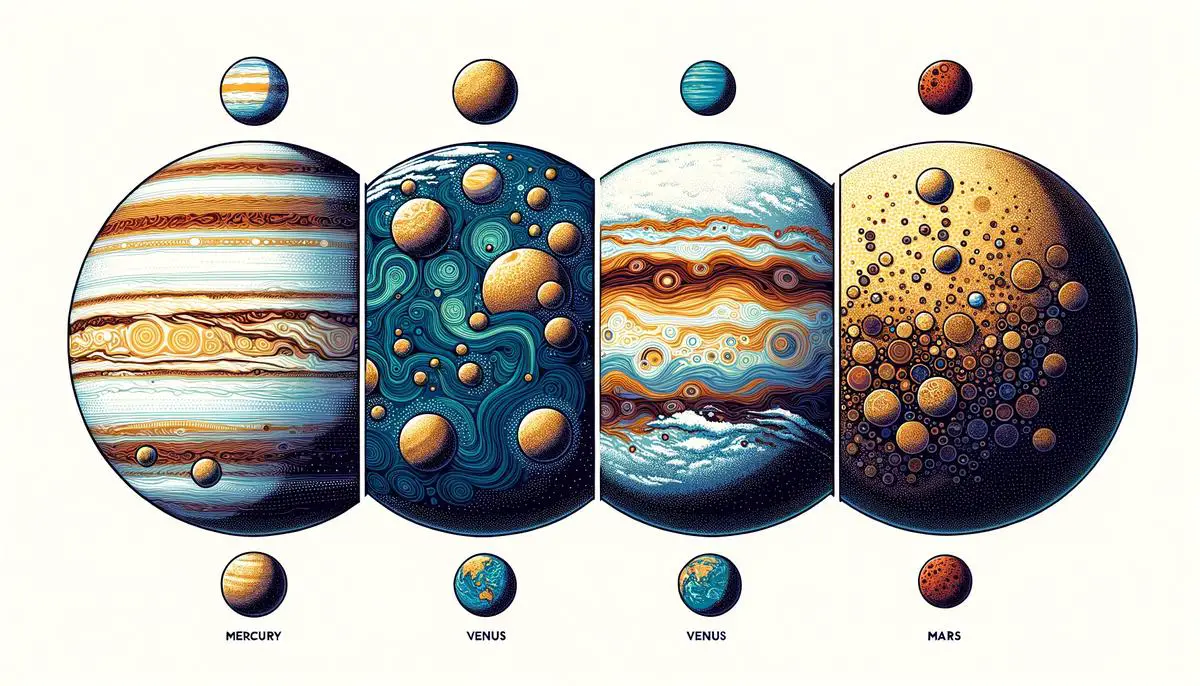As we turn our gaze towards the heavens, the terrestrial planets within our solar system present a tableau of atmospheric narratives, each woven from the threads of cosmic and geological events. These stories, rich in detail and variance, offer a profound understanding of the forces that shape planetary environments. By examining the atmospheres of Mercury, Venus, Earth, and Mars, we gain insights into the delicate balance that governs the climates and habitability of worlds beyond our own.
Origin & Evolution
Originally, these planets were bare, exposed to the vacuum of space. Atmospheric gases emerged through outgassing, a process closely linked with volcanic activity. Volcanoes, serving as natural conduits of the interior, release various gases such as water vapor, carbon dioxide, and nitrogen. Earth's oceans possibly originated from the relentless outgassing of volcanoes, spreading water vapor that eventually condensed into the vast, life-sustaining bodies we see today.
However, not all building blocks of atmospheres were internally sourced. Comets and asteroids, icy and volatile-rich objects, bombarded the young planets. These impacts contributed significantly to their atmospheres, especially in the case of water. While it's tempting to envision comets as the sole architects, differences between the water in comets and Earth's oceans suggest a more nuanced collaboration involving asteroids as well.
The Sun's role in shaping the nascent atmospheres cannot be understated. Solar winds, streams of charged particles emanating from the Sun, have sculpted the planetary atmospheres. Mercury, with its negligible atmosphere, and Venus, with its thick carbon dioxide-rich envelope, illustrate how proximity to the Sun and a planet's gravitational grasp can influence atmospheric retention and loss. Mars, farther from the Sun, has had its atmosphere thinned dramatically over eons by solar winds.
The influence of water is evident in atmospheric evolution, particularly on Earth and Mars. Earth's atmosphere underwent a dramatic transformation with the advent of photosynthesis, turning a CO2-dominated air into one rich in oxygen. This change was a slow, relentless process that turned Earth into a cradle for life as we know it. Mars' story hints at liquid water's past presence, evidenced by dried riverbeds and polar ice caps, suggesting significant, albeit transient, atmospheric water vapor.
Through this exploration, we witness a complex interplay of volcanic outbursts, icy bombardments, solar winds, and the transformative power of water across millions of years. Each planet's atmospheric tale is unique, reflecting its journey through the cosmic expanse and painting a broader picture of the dynamic processes that shape worlds beyond our own.
Atmospheric Composition
Atmospheric Composition: A Diverse Tapestry
Delving into the atmospheric fabric of the terrestrial planets unveils a symphony of elements and compounds, each playing a unique role in defining the climate, appearance, and habitability of its respective world. Mercury, Venus, Earth, and Mars – despite their kinship in the solar family – host atmospheres as varied as the landscapes they enshroud.
Mercury: A Whisper in the Vacuum
Mercury's atmosphere, if one might call it that, is a mere exhalation, a thin veneer composed mainly of oxygen, sodium, hydrogen, helium, and potassium. This tenuous atmosphere is constantly replenished by the Sun's bombardment and the planet's surface materials. Ephemeral and ghost-like, it offers little protection from the Sun's intensity or the cold of space, leaving Mercury a world of extremes.
Venus: A Cloak of Heat
In stark contrast, Venus boasts an atmosphere as thick as mythological veils, dominated by carbon dioxide with dense clouds of sulfuric acid high above. Nitrogen makes a modest appearance, but it's the overwhelming presence of CO2 that leads the dance, trapping heat in a relentless greenhouse effect1. This atmospheric composition has turned Venus into a realm of scorching temperatures and crushing pressures, a reminder of Earth's potential fate should our environmental vigilance falter.
Earth: A Symphony of Life
The Earth's atmosphere sings of balance and breath. Nitrogen and oxygen dominate our air, a composition that fuels and is replenished by the biosphere. Our planet's atmosphere is a tapestry woven with water vapor, creating clouds, rains, and a blanket that moderates our world's climate. Trace gases like carbon dioxide, methane, and ozone add complexity to this mix, contributing to the greenhouse effect that keeps Earth hospitable2. Here, in this fine equilibrium, life thrives in its myriad forms.
Mars: Echoes of Water
Mars appears as the remnant of a world once flush with potential. Its atmosphere, thin and weary, is mostly carbon dioxide with nitrogen, argon, and a smattering of other gases, including a tantalizing amount of water vapor. This vapor whispers tales of ancient rivers and seas, hinting at a Mars that once might have harbored life. Now, what remains is a world caught in an endless chill, its climate too frigid and air too sparse to support life as we know it.
Each terrestrial planet, through the lens of its atmosphere, reveals not just its current state but its history and its future possibilities. These atmospheres – Mercury's quiet solitude, Venus' oppressive embrace, Earth's nurturing caress, and Mars' wistful sighs – demonstrate the power of gases like carbon dioxide, nitrogen, and oxygen in crafting not just climates but worlds. The presence of water vapor, limited or abundant, whispers of life's potential – either flourishing, as on our blue dot; missed and longed for, as on Mars; or sizzling under a toxic shroud, as on Venus.
In understanding these atmospheric compositions, we grasp not just the science of worlds but the essence of planets. It's a tale of cosmic chance, geological fortune, and the relentless march of chemistry and physics – painting portraits of worlds that could have been, are, and might yet be.

Greenhouse Effect
How Does the Greenhouse Effect Vary Across Terrestrial Planets?
The Solar System is adorned with planets, each cloaked in their atmospheres, weaving the intricate patterns of climate and weather. Among the threads that contribute to this pattern, perhaps none is as crucial and yet as misunderstood as the greenhouse effect. This phenomenon, in essence, acts as a key factor in shaping planetary climates, ensuring that each world maintains its thermal balance. Let's explore the greenhouse effect across Venus, Earth, and Mars, unraveling the nuances that differentiate their climatic conditions.
Venus: The Runaway Greenhouse
On Venus, the greenhouse effect takes center stage with a magnitude that borders on the extreme. This planet, enveloped in a dense atmosphere predominantly of carbon dioxide, serves as a stark example of a greenhouse effect unleashed. Venus's atmospheric blanket traps solar radiation relentlessly, generating surface temperatures hot enough to melt lead. The thick cloud cover, rich in sulfuric droplets, acts as an additional layer, reflecting sunlight yet trapping infrared radiation. This has transformed Venus into a veritable furnace, with surface temperatures soaring to a scorching 735 K (462°C). Here, the greenhouse effect is not merely a climatic factor but a dominant force, an eternal reminder of its power when given free reign.
Earth: The Balanced Greenhouse
Our home, Earth, presents the greenhouse effect at its most benevolent, a delicate balance that sustains life. Earth's diverse atmospheric composition, with water vapor, carbon dioxide, methane, and nitrous oxide playing key roles, creates an ideal greenhouse scenario. This balanced accumulation of greenhouse gases captures just enough solar warmth to offset the planet's inherent chill, maintaining a global temperature conducive to a diverse biosphere3. Earth's greenhouse effect maintains temperatures averaging around 288 K (15°C), fostering a world where life thrives in abundant diversity. It serves as a vivid illustration of the greenhouse effect at its nurturing optimum, fostering a climate that is 'just right'.
Mars: The Weakened Greenhouse
Mars whispers tales of climatic history through its thin veil of carbon dioxide. Once perhaps cradling rivers and lakes beneath its rusty skies, Mars now confronts the weakening of its greenhouse effect. The Martian atmosphere, a wisp compared to Earth's or Venus's substantial blankets, struggles to retain solar warmth. Yet, this fragile embrace is insufficient to ward off the profound cold of space. The result is a world trapped in a perpetual chill, with average temperatures hovering at a frigid 210 K (-63°C)4. Mars epitomizes a greenhouse effect diminished, a planet delicately poised between the memory of warmth and the reality of its frozen present.
Comparing the intensity and impact of the greenhouse effect across these terrestrial worlds illuminates the variances in their atmospheric composition. Venus's runaway greenhouse offers a cautionary tale of thermal excess; Earth demonstrates equilibrium, where life flourishes within the temperate embrace of its atmosphere; Mars reflects the fading vestiges of warmth, a globe in the winter of its climatic history.
This exploration unravels not only the scientific underpinnings but also the implications inherent in the planetary atmospheres. The greenhouse effect, in delineating the climates of these worlds, weaves a narrative rich with implications for habitability, climate patterns, and perhaps the future trajectories of these terrestrial planets. In pondering these variations, we obtain not merely an academic understanding but a cosmic perspective – a viewfinder into the realms of possibility and the legacies of atmospheric dynamics.

Atmospheric Pressure & Temperature
Atmospheric Pressure and Temperature Conditions: Exploring Planetary Climates
Embarking on a journey through the terrestrial planets, we find ourselves exploring the diverse landscapes of Mercury, Venus, Earth, and Mars. Let's descend through their atmospheres, if they possess one, to examine the interplay of pressure and temperature – two critical factors in every planet's climate, habitability, and the potential for liquid water.
Mercury: A Touch by the Solar Wind
On Mercury, the atmosphere—or rather, exosphere—barely grazes the rugged surface. Here, the concept of atmospheric pressure is nearly negligible, with values so low that they make the void of space appear dense by comparison. Temperature exhibits a stark contrast; sunlight heats the surface to a scorching daytime high of approximately 700 K (427°C), while the absence of a substantial atmosphere allows drastic drops to 80 K (-193°C) during the lunar night. Liquid water here is an impossibility, its presence precluded by extreme temperatures and a lack of protective atmospheric shield against solar and cosmic radiation.
Venus: The Crushing Embrace
As we enter Venus's golden veil, the concept of atmospheric pressure takes a remarkable turn. A dense blanket of largely carbon dioxide engulfs the planet in pressures 92 times that of Earth's at sea level—a crushing embrace capable of flattening unshielded spacecraft. Temperatures manifest the intense greenhouse effect, remaining steady at 735 K (462°C) regardless of day or night5. Such conditions bring weather systems of acid clouds but completely rule out the existence of liquid water, relegating Venus's past aqueous hints to the remnants of volcanic and erosive features.
Earth: Symphony in Pressure and Weather
Earth stands as the maestro of balance among its terrestrial kin. Our atmosphere—a blend led by nitrogen and oxygen—composes songs of climate and breath at pressures averaging 101.3 kPa. This aerial environment moderates a globe-spanning range of temperatures generally centered around 288 K (15°C), conducive to life's diverse symphony. From gentle breezes to powerful storms, the varied atmospheric forces shape the world, allowing liquid water to flow freely across vast oceans and frozen poles alike. Herein lies the stronghold of life's resilience and dynamism.
Mars: The Whispering Winds
Transitioning to Mars, the celestial wanderer cloaked in myths of war and water, we encounter an atmosphere thin and worn from solar winds' caress. Its atmospheric pressure, less than 1% of Earth's, speaks softly to any visitor, a delicate touch contrasted sharply against the theoretical capability for flight. Temperature dips into the realm of cold with averages near 210 K (-63°C), quietly recalling tales of ancient warmth possibly harbored under a denser atmospheric past. Mars straddles the reality of frigid deserts dotted with polar ice caps and dreams of once flowing waterways, carved in the time-worn features of its surface.
Our journey through the heart of terrestrial atmospheres paints a vast panorama: from Mercury's faint whispers to Venus's crushing embrace; Earth's nurturing caress to Mars's gentle sighs. Atmospheric pressure and temperature stand as sculptors, shapers of the destiny concerning weather patterns, potential for liquid water, and the threads of habitability. Each terrestrial sphere tells its story through harmonies of physics and chemistry, echoing tales from silken water dreams to powerful tempests. It's a testament to nature's artistry, variably applied across rocky canvases spinning quietly through the cosmic expanse.

Human Impact
Human Affairs & Celestial Comparisons: Earth's Atmospheric Turmoil & Tranquil Cousins
The atmospheric evolutions of Mercury, Venus, and Mars contrast starkly with Earth's, where human activities play a pivotal role in shaping unprecedented atmospheric transformations.
Mercury, Venus, Mars: The Stoic Watchers
- Mercury's atmosphere barely persists against solar tempests.
- Venus thrives in a dense CO2 atmosphere with a potent greenhouse effect.
- Mars' atmospheric history tells of solar winds eroding its once thicker atmosphere.
These planetary atmospheres evolve largely unperturbed by conscious will or industrial activities.
Earth: The Canvas of Human Ambition
Earth's atmospheric narrative intertwines with the anthropogenic pulse. Pollution from industries and agriculture has inscribed indelible marks on Earth's atmosphere. The enhanced greenhouse effect, driven by human-emitted gases, is steering the planet towards significant climatic changes.
In a geologically brief time, human activities have released CO2 volumes rivaling ancient volcanic events1. Earth's atmosphere accrues impacts from its lifeforms' activities, manifesting in rising temperatures, acid rain, and climate disruptions. The ozone layer bears scars from human-made chemicals released into the atmosphere2.
Reflections in a Cosmic Mirror
The contrast between the natural evolutions of Mercury, Venus, and Mars' atmospheres and Earth's human-influenced story serves as a reflection of our impact. Where natural forces shape the destinies of our planetary neighbors, Earth testifies to the profound influence of its most intelligent species. It raises the question: As stewards of this planet, what legacy do we leave in the atmosphere that sustains life?
This is not merely a story of vulnerability but also of responsibility. The future chapters of Earth's atmospheric tale are ours to write. Will it be a saga of rejuvenation, where sustainable practices harmonize with nature? Or will it remain a cautionary tale of a species that pushed its environment too far?
Earth's narrative grows ever more complex with human activity—a story reflecting hope and challenge, wisdom and folly. As caretakers of this planet, we hold the pen to Earth's unfolding legacy, shaping the thin veneer we call the atmosphere.
Earth's atmosphere stands as a testament to the profound impact of its most intelligent inhabitants. As we reflect on the atmospheric tales of our neighboring planets, untouched by conscious endeavor, Earth's narrative underscores a pivotal responsibility. It is a compelling reminder that the stewardship of this delicate atmospheric balance rests in our hands, challenging us to forge a legacy of harmony with the natural world. This stewardship is not just an opportunity but a solemn duty to ensure that Earth's atmospheric tale continues to be one of vitality and resilience.

![]()
